Rylance Surname Ancestry ResultsOur indexes 1000-1999 include entries for the spelling 'rylance'. In the period you have requested, we have the following 72 records (displaying 61 to 70): Single Surname Subscription | | | Buying all 72 results of this search individually would cost £426.00. But you can have free access to all 72 records for a year, to view, to save and print, for £100. Save £326.00. More... |
These sample scans are from the original record. You will get scans of the full pages or articles where the surname you searched for has been found. Your web browser may prevent the sample windows from opening; in this case please change your browser settings to allow pop-up windows from this site. Soldiers wounded in the Great War: York & Lancaster Regiment
(1916)
Lists of names of soldiers wounded, died of wounds, died, killed, missing presumed dead, and taken prisoner by the enemy, were issued to the British national press under the title Roll of Honour. Each man is identified by surname, initials and number. The regimental returns from which the daily Roll was compiled were made up over the previous week or weeks. Each regimental return may be partial, covering only part of the alphabet. The lists are provisional, in that a man reported wounded one day may appear as died of wounds later; a missing presumed dead may later be reported as having been found, or as having died; the lists of prisoners of war were provided by the enemy and will relate to captures weeks earlier. However, these rolls are the most comprehensive single source of names of British and allied combatants meeting with misfortune in the Great War. This is the roll published 1 August 1916. The sample scan is taken from a section of the Roll of Honour for the Manchester Regiment.RYLANCE. Cost: £6.00.  | Sample scan, click to enlarge
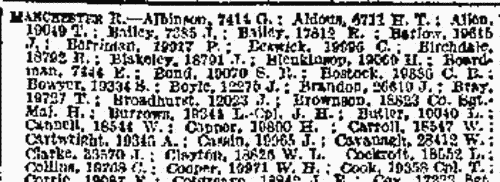
| Boys entering King William's College, Isle of Man
(1926)
King William's College at Castletown on the Isle of Man was established in 1830. By 1928 about 290 boys were being educated there, 'of whom three-fourths are boarders, and the remainders sons of natives or residents in the Island.' Boys entered the junior school about 9 or 10 years of age, the upper school about 13; boys over 13 were not admitted 'unless attainments and character are specially satisfactory'. There were 'several nominations for the sons of clergy and others'.
Editions of the college register were published in 1905 and 1927. When this third edition was prepared, in 1956, it was felt unnecessary to repeat the whole of the register from 1830 onwards, a new starting point being chosen as September 1886, when the reverend Frank Bridgman Walters took office as principal.
The items are arranged alphabetically within term of entry; surname is given first, in bold, and then full christian names; then, to the right, in bold, precise date of birth, school house, and month of leaving the school. The abbreviations for houses are: C, Colbourne; D, Dickson; H, Hunt; Ha, Hangoside; J, Junior House; R, Raglan; S, School House (formerly Principal's); T, town houses occupied by masters who took in boys prior to September 1889; Tr, Trafford's; W, Walters.
Each entry then gives the boy's father's name (surname and initials) and address at that time; school honours (such as Prae., praepositor, XI, school cricket team); a career synopsis; and finally, in italics, to the right, year of death, or present address in 1956, if known.RYLANCE. Cost: £4.00.  | Sample scan, click to enlarge
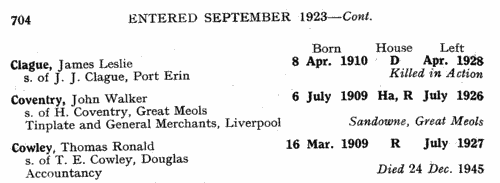
| Members of Oxford University: Women
(1931)
The Oxford University Calendar for 1931 includes this list of all living members of the university, i. e. not only undergraduates and members of staff, but also all surviving graduates from earlier generations. The names are arranged alphabetically by surname, then by college in order of foundation. Surnames are given, initials, highest degree, name of college, and then the year of graduating the first degree. For undergraduates only name and college is given. An asterisk before a surname indicates a member on the foundation of the college. There are separate lists for men and women. In the women's list italic type indicates the maiden names under which married women were first registered as women students in the university: both maiden and married surnames are included in our index.RYLANCE. Cost: £4.00.  | Sample scan, click to enlarge
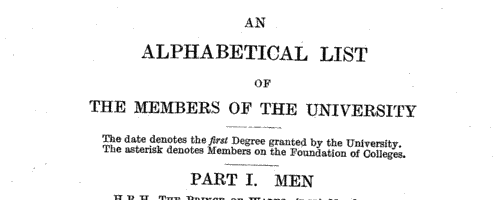
| Congregationalists
(1935)
Who's Who in Congregationalism gives biographical notices of accredited ministers and evangelists, lay pastors and lay officials of the Congregational church in Britain and Ireland. The notices also include the names of wives, with maiden names, and these too are included in the index here.RYLANCE. Cost: £6.00.  | Sample scan, click to enlarge
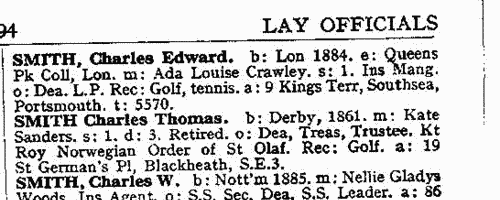
| Boys entering King William's College, Isle of Man
(1938)
King William's College at Castletown on the Isle of Man was established in 1830. By 1928 about 290 boys were being educated there, 'of whom three-fourths are boarders, and the remainders sons of natives or residents in the Island.' Boys entered the junior school about 9 or 10 years of age, the upper school about 13; boys over 13 were not admitted 'unless attainments and character are specially satisfactory'. There were 'several nominations for the sons of clergy and others'.
Editions of the college register were published in 1905 and 1927. When this third edition was prepared, in 1956, it was felt unnecessary to repeat the whole of the register from 1830 onwards, a new starting point being chosen as September 1886, when the reverend Frank Bridgman Walters took office as principal.
The items are arranged alphabetically within term of entry; surname is given first, in bold, and then full christian names; then, to the right, in bold, precise date of birth, school house, and month of leaving the school. The abbreviations for houses are: C, Colbourne; D, Dickson; H, Hunt; Ha, Hangoside; J, Junior House; R, Raglan; S, School House (formerly Principal's); T, town houses occupied by masters who took in boys prior to September 1889; Tr, Trafford's; W, Walters.
Each entry then gives the boy's father's name (surname and initials) and address at that time; school honours (such as Prae., praepositor, XI, school cricket team); a career synopsis; and finally, in italics, to the right, year of death, or present address in 1956, if known.RYLANCE. Cost: £4.00.  | Sample scan, click to enlarge
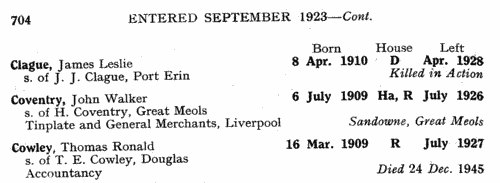
| London Telephone Subscribers
(1939)
The London telephone directory lists subscribers alphabetically by surname and then by christian name or initials, with their postal address and telephone number. This is the L to Z directory issued in May 1939, but also contains some names from earlier in the alphabet, for instance in the separate section for midwives. The London telephone districts comprised not only the city centre, but also the very extensive suburbs in the Home Counties (Essex, Kent, Surrey and Middlesex).RYLANCE. Cost: £4.00.  | Sample scan, click to enlarge

| Royal Corps of Signals: Regular Army Emergency Commissions: 2nd Lieutenants
(1946)
The Army List for October 1946 lists the 4300 officers of the Royal Corps of Signals by rank and seniority (i.e., the date from which their particular rank was to be reckoned). The names are given as surnames and initials. The many temporary commissions bestowing brevet or higher rank are listed in italics, with date, together with any decorations. In front of the surnames three abbreviations may occur: a bold R, meaning released to unemployment; a crossed-swords symbol for meritorious war service; and a pilcrow, for service without pay and allowances. There are separate sections for retired officers temporarily re-employed, the Territorial Army, and Regular Army Emergency Commissions (including African Colonial, Caribbean, Egypt and Palestine forces), Supplementary Reserve Category B.
RYLANCE. Cost: £4.00.  | Sample scan, click to enlarge
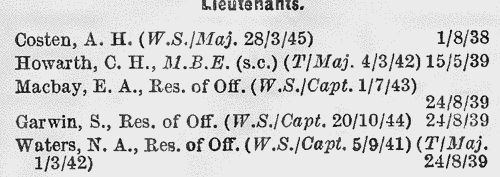
| Doctors in London
(1948)
The Medical Directory was split into several sections. The London section covered all medical practitioners resident within the London postal district. Each year a schedule was sent to each doctor to be returned to the publishers, so as to keep the directory up to date. In the directory the doctor's name is given first, in bold, surname first, in capitals; then current address. Next are the qualifications; the italic abbreviations in parentheses following the qualifications indicate the medical school at which they were gained. Then there is a list of posts and honours within the profession, starting with those then current; previous posts are preceded by the word 'late'. Finally, brief details are given of any publications.RYLANCE. Cost: £2.00.  | Sample scan, click to enlarge
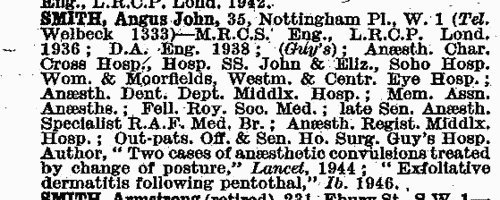
| Members of the Institution of Mining Engineers (M. I. Min. E.)
(1949)
The Institution of Mining Engineers was established 1 July 1889 and incorporated by royal charter 9 February 1915. This list of members is corrected up to 28 December 1949. Five grades of members are listed: Honorary Members (Hon. M. I. Min. E.); Members (M. I. Min. E.); Associate Members (Assoc. M. I. Min. E.); Students (Stud. I. Min. E.); and Associates (Assoc. I. Min. E.). The grade of Member comprised all persons who were registered as associates on 31 January 1933: every candidate for admission to that class after that date must be a person at least 30 years of age who 'shall have been so educated and trained as to be in the opinion of the Council a fully qualified Mining Engineer' and have acted for at least five years as a qualified colliery manager, &c.; or 'he shall be a person whose position and attainments in Science or Technology justify, in the opinion of the Council, his election as a Member'. The members' names are listed alphabetically (in bold) by surname and christian name, with full address. On the right hand side are initials indicating to which federated institute he or she belonged: M. C., Midland Counties Institution of Engineers; M. G., Manchester Geological and Mining Society; M. I., Midland Institute of Mining Engineers; N. E., North of England Institute of Mining and Mechanical Engineers; N. S., North Staffordshire Institute of Mining Engineers; S. S., South Staffordshire and Warwickshire Institute of Mining Engineers; and S. W., the South Western Society of Mining Engineers.RYLANCE. Cost: £4.00.  | Sample scan, click to enlarge
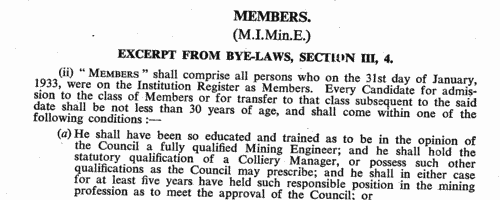
| Chemists
(1950)
The Royal Institute of Chemistry was founded in 1877, and was open only to British subjects (and also, in due course, to citizens of the newly-created Republic of Ireland). Associates of the institute (A. R. I. C.) qualified either by studying chemistry, physics, mathematics and an optional science for the institute's examination (which insisted on a high standard of practical laboratory efficiency); or by obtaining good honours degrees or equivalent qualifications, with chemistry as principal subject, and having undergone training in allied sciences. Associates of at least three years' standing could then be admitted to the Fellowship (F. R. I. C.) either by taking a further examination in a special branch of chemistry, or by submitting the results of work or evidence of experience sufficient to justify the Council in granting exemption from such further examination. This register of fellows and associates, correct to 31 August 1950, contains 11,545 names, arranged alphabetically, surname first (in capitals), with qualifications, current address, telephone number, and (in italics) a brief description of present post in the chemical industry. Finally, year of admission as associate (A.) (and, where appropriate, fellow (F.) is given on the right-hand side. With this may appear the notation (x) for a fellow of the Chemical Society, (y) for a member of the Society of Chemical Industry, or (z) for a joint subscriber to all three chartered bodies.RYLANCE. Cost: £4.00.  | Sample scan, click to enlarge

|
Research your ancestry, family history, genealogy and one-name study by direct access to original records and archives indexed by surname.
|












